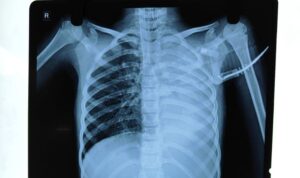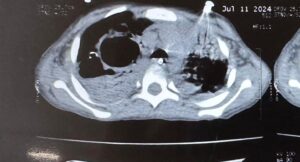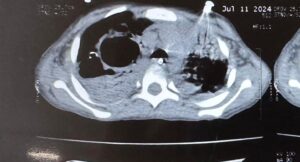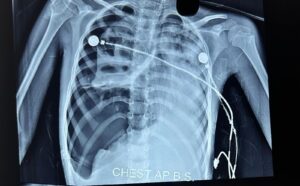Assessment of hemodynamic conditions is most important in the management of critically ill patients
It is most important to pick up the condition of compensated shock and start treatment
Pediatric patients go into the stage of decompensated shock a bit late in comparasion to adult patients
Patients are managable in condition of decompesated shock if timely intervention is done.
Once the patient passes into irreversible shock it is very very difficult to revive and mortality is very high
How to recognise a patient clinically in a state of shock
STATE OF STABLE HEMODYNAMICS
Patient has clear consciousness
Periphery is warm and pink
Capillary refill time is 2 seconds or less
Pulse volume is good on palpation
Blood pressure is normal( between 5th to 95th centile for the age
Respiratory rate in the normal range for the age
Heart rate in the normal range for the age
Urine output normal for the age,1ml /kg/hour
STATE OF COMPENSATED SHOCK
Conscioussness inact
Periphery cool
Peripheral pulse ,low volume or thready
Capillary refill time more than 2 seconds
Blood pressure ,systolic is normal but diastolic is in rising trend,postural hypotension,narrow pulse pressure
Heart rate increased for the age
Respiratory rate increased for the age
Urine output reduced
STATE OF DECOMPENSATED SHOCK
Conscioussness-Restlessness or the patient is combative
Periphery on touch is cold and clammy
Capillary refill time is very prolonged like 5 seconds or more with or without mottling of skin
Peripheral pulse is very weak or may not be palpable at all even with great effort
Blood pressure -Hypotension,pulse pressure is 20 mm or less.Blood pressure may not be recordable
Heart rate-increased and in late stage decreased
Respiratory rate-Hyperpnea or Kussmaul breathing pattern(deep and sighy)
Urine output-oliguria or anuria
NORMAL RANGE of Respiratory rate
Premie-40-70/minute
0-3 months-30-60/minute
3-6 months-30-45/minute
6-12 months-25-40/minute
1-3 years-20-30/minute
3-6 years-20-25/minute
6-12 years-14-22/minute
>12 years 12-18/minute
NORMAL RANGE of heart rate- per minute
Premie 120-170
0-3 months 110-160
3-6 months 100-150
6-12 months 90-130
1-3 years 80-125
3-6 years 70-115
6-12 years 60-100
>12 years 60-100
HYPOTENSION is called when systolic blood pressure is below
60mm of Hg in NEW BORN,
70 mm of Hg between the age of 1 month to 1 year
70 mmHg+age in years multiplied by 2 ,between the age of 1- 10 years
90 mm Hg above the age of 10 years
Hypotension is also called when mean arterial pressure (MAP)is below 40+age in years multiplied by 1.5
MANAGEMENT:Management should start at the earliest, at the stage of compensated shock
First attention should be on airway and breathing and oxygen should be given if required to keep SPo2 95% and above
Life saving -for the circulation to be maintained, is fluid therapy
20 ml/kg of N/S or R/L shuold be given over 5-15 minutes and it should be pushed.It can be repeated twice if hydration,circulation and perfusion is not adequate.
In the settings of obvious fluid loss like diarrhoea ,vomiting or hemorrhage ,repeated fluid administration should be done till the signs of fluid overload develop, in the form of tachycardia,bilateral deep inspiratory crackles over subscapular region,liver enlargement,engorgement of jugular vein or signs of pulmonary edema on chest X-Ray
R/L shuold not be used in case of a history of repeated vomiting
IV bolus should be repeated ,only when there is sign of improvement clinically and no sign of fluid overload.
Aggressive fluid therapy may be harmful and should not be given in certain situations like shock in the settings of severe acute malnutrition,severe anemia,compensated shock with high fever with no dehydration or obvious fluid loss(Dengue fever),cardiogenic shock(ductal dependent congenital heart disease in newborn),obstructive shock(tension pneumothorax,cardiac temponade,)
SIGHNS OF CARDIOGENIC SHOCK-Tachycardia,engorged jugular vein,bilateral deep inspiratory crackles over subscapular regions,gallop rhythm,liver enlargement,signs of pulmonary edema on chest X-Ray.
In these cicumstances,crystalloids(N/S or R/L) should be given in the dose of 5-10 ml per kg over 15-30 minutes once then switch over to vasopressors
In case of poor response or no response to fluid therapy,swith over to vasopressures without delay.
If the periphery is cold,give DOPAMINE/EPINEPHRINE
If the perphery is warm give NORADRENALINE
In case of myocardial dysfuntion with maintained blood pressure,give DOBUTAMINE
In case of myocardial dysfuntion with increased peripheral resistance,use MILRINONE
Easy preparation and administration of vasopressures
Dopamine/Dobutamine 6 mg/kg-dilute in 100 ml of D5-1 ml/hour of this will deliver 1 mcg/kg/minute=Dose is 5-20 mcg/kg/minute
EPINEPHRINE0.6mg/kg of body weight,dilute in 100 ml of D5-1ml/hour will deliver 0.1mcg/kg/minute=Dose 0.05 to 0.2mcg/kg/minute,in severe cases upto 1mcg/kg/minute
Norepinephrine 0.6 mg/kg,dilute in 100 ml D5,1ml/hour will deliver 0.1mcg/kg/minute=Dose 0.1-1mcg/kg/hour
REFERENCES1.;Harriet Lane 21 edition
2. CDC guideline on management of shock in children
3.Uptodate-management of shock in children,2021
 This child had been admitted in critical condtion in our Pediatric ICU.
This child had been admitted in critical condtion in our Pediatric ICU.
 en
en
